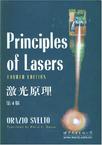激光原理
出版时间:2008-3 出版社:世界图书出版公司 作者:斯威尔托 页数:604
Tag标签:无
内容概要
This new Fourth Edition of Principles of Lasers is so thoroughly updated and expanded that it is virtually a whole new book。 But the text s essential mission remains the same: to provide a wide-ranging yet unified description of laser behavior, physics, technology, and current applications。 Dr. Svelto emphasizes the physical rather than the mathematical aspects of lasers, and presents the subject in the simplest terms compatible with a correct physical understanding。 作者简介: Orazio Svelto is Professor of Quantum Electronics at the Polytechnic Institute of Milan and Director of the Quantum Electronics Center of the Italian National Research Council。 His research has covered a wide range of activity in the field of laser physics and quantum electronics, starting from the very beginning of these disciplines。This activity includes ultrashort-pulse generation and applications,development of laser resonators and mode-selection techniques,laser applications in biology and medicine, and development of solid-state lasers。 Professor Svelto is the author of more than 150 scientific papers and his researches have been the subject of more than 50 invited papers and international conferences。 He has served as a program chair of the IX International Quantum Electronics Conference(1976),as a chair of the European program committee for CLEO 85 and CLEO 90, and he was general co-chair for the first CLEO-Europe Conference(1994)。He is an elected member of the Italian“Accademia dei XL” and a Fellow of the IEEE。
书籍目录
Lists of Examples1. Introductory Concepts 1.1 Spontaneous and Stimulated Emission, Absorption 1.2 The Laser Idea 1.3 Pumping Schemes 1.4 Properties of Laser Beams 1.4.1 Monochromaticity 1.4.2 Coherence 1.4.3 Directionality 1.4.4 Brightness 1.4.5 Short Pulse Duration 1.5 LaserTypes Problems2. Interaction of Radiation with Atoms and Ions 2.1. Introduction 2.2. Summary ofBlackbody RadiationTheory 2.2.1 Modes of a RectangularCavity 2 2.2 Rayleigh-Jeans and Planck Radiation Formula 2.2.3 Planck’s Hypothesis and Field Quantization 2.3 Spontaneous Emission 2.3.1 Semiclassical Approach 2.3.2 Quantum Electrndynamics Approach 2.3 3 Allowed and F0rbiddenTransitions 2.4 Absorption and Stimulated Emission 2.4.1 Absorption and Stimulated Emission Rates 2.4.2 Allowedand ForbiddenTtansitions 2.4.3 Transition Cross Section,Absorption.and Gain Coe佑cient 2.4.4 Einstein Thermndynamic Treatment 2.5 Line-Broadening Mechanisms 2.5.1 Homogeneous Broadening 2.5.2 Inhomogeneous Broadening 2.5.3 Concluding Remarks 2.6 NonradiativeDecay and Energy Transfer 2.6.l Mechanisms Of Nonradiative Decay 2.6.2 Combined EfieCtS of Radiative and Nonradiative Processes 2.7 Degenerate or Strongly Coupled Levels 2.7.l Degenerate Levels 2.7.2 Strongly Coupled Lex,els 2.8 Saturation 2.8.l Saturation of Absorption:Homogeneous Line 2.8.2 Gain Saturation:Homogeneous Line 2.8.3 InhOmogeneously Broadened Line 2.9 Fluourescence Decay of an Optically Dense Medium 2.9.1 Radiation Trapping 2.9.2 Amplified Spontaneous Emission 2.10 Concluding Remarks Problems References 3. Energy Levels Radiative and Nonradiative Transitions in Molecules and Semiconductors 3.1 Molecules 3.1.1 Energy Levels 3.l.2 Level 0ccupation at Thermal Equilibrium 3.1.3 Stimulated Transitions 3.l.4 Radiative and Nonradiative Decay 3.2 Bulk Semiconductors 3.2.1 Electronic States 3.2.2 Density of States 3.2.3 LeveI Occupation at Thermal Equilibrium 3.2.4 Stimulated Transitions:Selection Rules 3.2.5 Absorption andGain Coefficients 3.2.6 Spontaneous Emission and Nonradiative Decay 3.2.7 Concluding Remarks 3.3 Semiconductor Ouantum Wells 3.3.1 Electronic States 3.3.2 Density of States 3.3.3 Level Occupation at Therrnal Equilibrium 3.3.4 Stimulated Transitions:Selection Rules 3.3.5 Absorption andGain Coefficients 3.3.6 StrainedQuantumwells 3.4 Quantum Wires and Quantum Dots 3.5 Concluding Remarks Problems References 4. Ray and Wave Propagation through Optical Media 4.1 Introduction 5. Passive Optical Resonators6. Pumping Process7. Continuous Wave Laser Behavior8. Transient Laser Behavior9. Solid-State, Dye, and Semiconductors Lasers10. Gas. Chemical, Free-Election, and X-Ray Lasers11. Properties of Laser Beams12. Laser Beam Transformation:Propagation, Amplification, Frequency Conversion, Pulse Compression, and Pulse ExpansionAppendixesAnswers to Selected ProblemsIndex
图书封面
图书标签Tags
无
评论、评分、阅读与下载
用户评论 (总计2条)
- 好书,就是世界图书出版社印刷质量,纸张质量太差,像草稿纸
- 印刷质量太差,纸张也不好。真怀疑是不是正版图书!
相关图书
- 大象的精神Spirit of the Elephant
- Think Again重新考虑
- 东部 East Side General
- 2010考研数学标准全书
- オノ・ナツメ短編集TESORO~テゾーロ
- 核医学临床实习指南
- 邱比特的恶作剧Ⅰ 虹玉
- 千一秒物語 (GUSH COMICS)
- 暗星薩伐旅.
- 变形记
- 創意城市
- 梦断代码
- 韩复榘这个人
- 开心妈妈孕育宝宝有妙招
- 當我遇上以色列
- ミステリーズ!vol.29
- 庞大的象SAGGY BAGGY ELEPHANT, THE
- 生物化学实验
- 流域分布式水文学原理及应用
- 地下水水文学原理
- 如逝如歌
- 隋唐五代史
- 全新英语读写一体化教程;阅读与写作(下)
- MBA联考英语阅读理解精读80篇
- 基础化学教程习题解析
